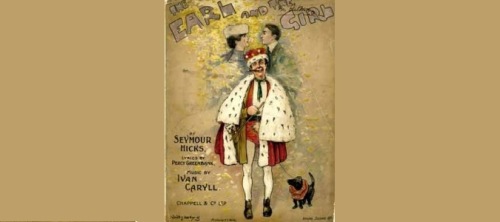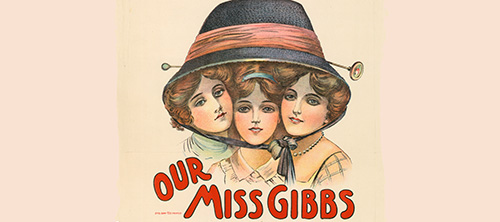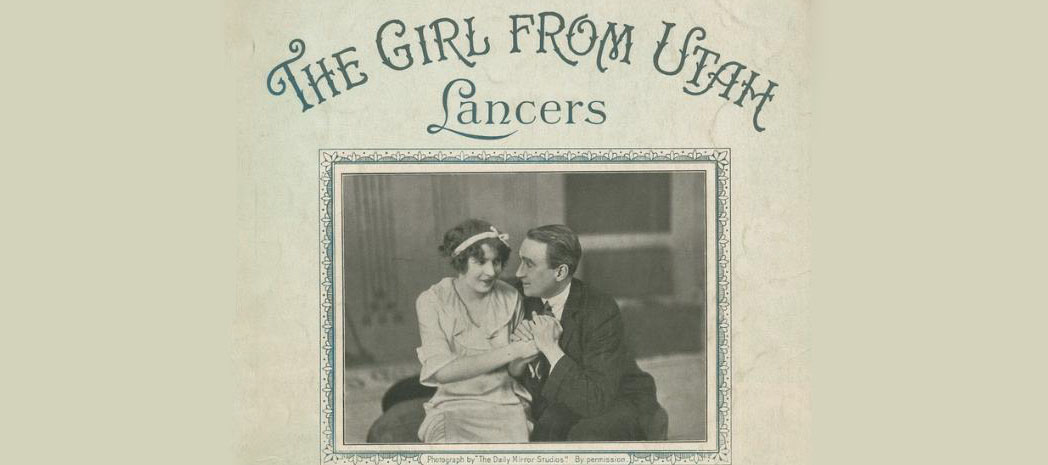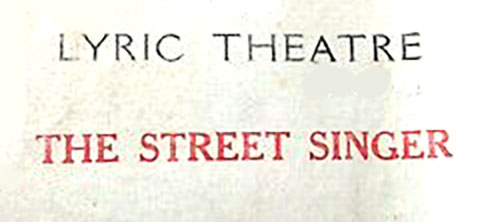Pas de biographie disponible.
Compositeur Musique additionelle Librettiste Parolier Metteur en scène Chorégraphe Producteur création Producteur version

Musical
Musique: Ivan Caryll • Paroles: Percy Greenbank • Livret: Seymour Hicks • Production originale: 2 versions mentionnées
Dispo: Synopsis Commentaire Génèse Liste chansons
Genèse: The Earl and the Girl is a musical comedy in two acts produced by William Greet and opened at the Adelphi Theatre in London on 10 December 1903. It transferred to the Lyric Theatre on 12 September 1904, running for a total of 371 performances. It also ran at the Casino Theatre in New York beginning on 4 November 1905 for 148 performances (with some added music and lyrics by Jerome Kern and others), starring Eddie Foy and W. H. Denny. A production toured Australia in 1906 and 1907. A revival in London in 1914 ran for a total of 107 performances, and there were later revivals and tours. The original London cast included a number of performers who had recently appeared in productions of the D'Oyly Carte Opera Company, which was no longer performing at the Savoy Theatre at the time of the premiere of The Earl and the Girl, including Walter Passmore, Henry Lytton, Robert Evett, M. R. Morand, Reginald Crompton, Powis Pinder, Charles Childerstone, Alec Fraser, Ernest Torrence, Rudolph Lewis, Agnes Fraser, and Louie Pounds. Lytton later used the song "My Cosy Corner" from the show in his music hall acts with much success, and made a recording of it. Kern's song interpolated into the New York production, "How'd You Like to Spoon with Me?" also became a hit.
Résumé:
Création: 10/12/1903 - Adelphi Theatre (Londres) - représ.

Musical
Musique: Ivan Caryll • Lionel Monckton • Paroles: Adrian Ross • Percy Greenbank • Livret: James T. Tanner • Production originale: 2 versions mentionnées
Dispo: Résumé Synopsis Commentaire Génèse Liste chansons
Genèse: Produced by George Edwardes, it opened at the Gaiety Theatre in London on 23 January 1909 and ran for an extremely successful 636 performances. It starred Gertie Millar, Edmund Payne and George Grossmith, Jr. The young Gladys Cooper played the small role of Lady Connie. The show also had a short Broadway run in 1910. It was revived at the Finborough Theatre, London, in May 2006. This was the first professional London production since 1910. The piece was regularly revived by amateur theatre groups, particularly in Britain, from the 1920s into the 1950s but it has been produced only rarely since then. Our Miss Gibbs was revived by Lyric Theatre in July and August 2011 at the Mountain View Center for the Performing Arts and the Lesher Center for the Arts in Walnut Creek, California. The revival featured a cast of 22 and a 9-piece orchestra.
Résumé: Mary Gibbs, a Yorkshire Lass, works in the flower department of Garrod’s Department Store. Her heart belongs to the bank clerk Harry Lancaster (who is really Lord Eynsford in disguise). Lord Eynsford is engaged to Lady Elizabeth Thanet, but she much prefers Hughie Pierrepoint, an amateur criminal. When Mary discovers Lord Eynsford’s deception, she leaves her job and goes off to the Franco-British Exhibition at White City. Lord Eynsford follows her, proves his honourable intentions, and all gets sorted out happily.
Création: 23/1/1909 - Gaiety Theatre (Londres) - 636 représ.

Musical
Musique: Lionel Monckton • Paroles: Adrian Ross • Percy Greenbank • Livret: James T. Tanner • Production originale: 1 version mentionnée
Dispo: Synopsis Commentaire Génèse Liste chansons
Genèse: The Dancing Mistress was presented by the impresario George Edwardes at the Royal Adelphi Theatre, opening on 19 October 1912. The piece, which followed the same composer's and authors' immensely successful The Quaker Girl, featured many of the performers from the earlier show, including the romantic leads, Gertie Millar and Joseph Coyne. It ran at the Adelphi until 21 June 1913. A touring company presented the piece in the British provinces, with Adele Crispin, John T. MacCallum and Laura Wright in the leading roles of Nancy, Teddy and Virginie.
Résumé:
Création: 19/10/1912 - Adelphi Theatre (Londres) - 242 représ.

Musical
Musique: Paul Rubens • Sidney Jones • Paroles: Adrian Ross • Percy Greenbank • Livret: James T. Tanner • Production originale: 3 versions mentionnées
Dispo: Résumé Génèse Liste chansons
Genèse: La pièce fut créée à l'Adelphi Theatre de Londres le 18 octobre 1913 et connut une première série de 195 représentations. Une version américaine a été produite par Charles Frohman qui a eu connu un beau succès de 140 représentations au Knickerbocker Theatre (ouverture le 24 août 1914). Frohman a engagé le jeune Jerome Kern pour écrire cinq nouvelles chansons pour la partition avec le parolier Herbert Reynolds pour renforcer ce qu’il considérait comme un premier acte faible. Julia Sanderson et Donald Brian ont joué dans la production. Leur chanson "They Didn’t Believe Me" est devenue un succès. La comédie musicale a également tourné dans d’autres pays, dont l’Afrique du Sud, l’Australie et la Nouvelle-Zélande.
Résumé: Una Trance fuit sa maison et son mormonisme après la décision de son père de la "céder" à un habitant particulièrement horrible de Salt Lake City. Dans sa fuite, Una rencontre des bénévoles: Lord Amesham et sa fiancée, Dora; l’acteur Sandy Blair; un petit vendeur de jambon et de bœuf plutôt étrange, Trimmit et sa fiancée, Clancy, qui est aussi la bonne de Dora. Les choses deviennent plus mélodramatiques quand le redouté polygame attire Una et la moitié du chœur du Théâtre de la Folie dans sa demeure de Brixton, tandis que la police est sur une mauvaise piste à la poursuite de Trimmitt. qui a accidentellement ramassé un chapeau de Mormon dans un restaurant. Mais les détectives amateurs sont sur la bonne piste en suivant une traînée de confettis bleus que Una a laissé tomber dans son sillage. Enfin, Trimmit, déguisé en pompier, se précipite vers l’escalier de secours et, avec l’action de la pièce, tout le monde répare le Bal des Arts pour la fin des amours.
Création: 18/10/1913 - Adelphi Theatre (Londres) - 195 représ.

Musical
Musique: Howard Talbot • Lionel Monckton • Paroles: Adrian Ross • Percy Greenbank • Livret: Fred Thompson • Percy Greenbank • Production originale: 1 version mentionnée
Dispo: Synopsis Génèse Liste chansons
During the gloomy days of World War I, audiences, including servicemen on leave, wanted light and uplifting entertainment, and they flocked to theatres to see lighthearted musical comedies, a number of which broke box-office records. It opened at the Adelphi Theatre in London on 14 September 1917, and ran for 801 performances – one of the longest runs of any musical theatre piece up to that time.
Genèse: During the gloomy days of World War I, audiences, including servicemen on leave, wanted light and uplifting entertainment, and they flocked to theatres to see lighthearted musical comedies, a number of which broke box-office records. These included The Bing Boys Are Here (1916), Chu Chin Chow (1916), and The Maid of the Mountains (1917). Almost as popular were The Boy, The Happy Day (1916) and Yes, Uncle! (1917). Greenbank had worked on a dozen shows with each of Monckton and Ross from 1900 to the time of The Boy, and Talbot and Thompson were also frequent collaborators of theirs in the first two decades of the 20th century. The plot of The Boy closely follows that of The Magistrate, although character names have been changed, and some of the original dialogue is retained. In the Play Pictorial feature, B.W. Findon's review of the musical praised the singing of Nellie Taylor and Peter Gawthhorne, and the comedy of W. H. Berry, as well as the production in general. It opened at the Adelphi Theatre in London on 14 September 1917, directed by Robert Courtneidge, under the management of Alfred Butt, and ran for 801 performances – one of the longest runs of any musical theatre piece up to that time. The musical was later produced in Australia, starring Gladys Moncrieff. It was also adapted for Broadway as Good Morning, Judge in 1919, by the same creative team, at the Shubert Theatre, running for 140 performances and then touring successfully. Two songs by George Gershwin were added to the score, including "I am so Young," published as "I was so Young (You were so Young)." It starred George Hassell (as Mr. Meebles), Charles King (as Hughie), Mollie King (as Joy Chatterton) and Edward Martindel (as Col. Bagot). Although the piece was revived several times by amateur British groups in the 1930s, it has not been seen since then.
Résumé:
Création: 14/9/1917 - Adelphi Theatre (Londres) - 801 représ.

Musical
Musique: Harold Fraser-Simon • Paroles: Percy Greenbank • Livret: Frédéric Lonsdale • Production originale: 1 version mentionnée
Dispo: Résumé Liste chansons
Genèse:
Résumé: La duchesse de Versailles est tombée amoureuse de Bonni, un peintre pauvre au talent limité. Elle se déguise en Yvette, une chanteuse de rue, et prend contact avec son bien-aimé. Ils deviennent vite amants. Elle s’arrange ensuite pour acheter toutes ses peintures par l’intermédiaire d'un marchand d’art, Levy. Bonni pense qu’il a enfin trouvé la célébrité et que son génie a été reconnu. Au plus fort du carnaval, il reçoit une convocation pour rencontrer son mécène et quitte donc sa petite chanteuse de rue pour se rendre là où la célébrité et la fortune l’attendent. Cependant, il regrette rapidement son choix et déchire le chèque de la duchesse pour son dernier tableau et va jusqu'à découper le tableau - un portrait de son Yvette perdue - pour constater que la duchesse et la chanteuse de rue ne font qu’un. Une fin heureuse. Il y a bien sûr une sous-intrigue comique impliquant François, valet misogyne, et une jeune veuve fougueuse, Violette.
Création: 24/6/1924 - Lyric Theatre (Londres) - 360 représ.

.png)
.png)




